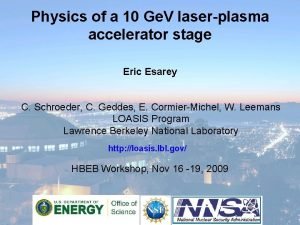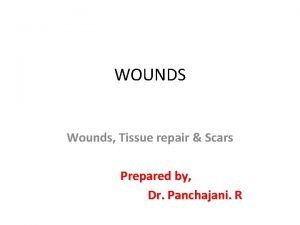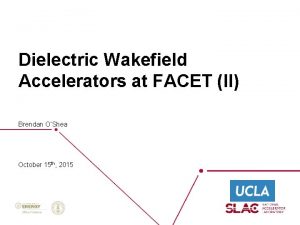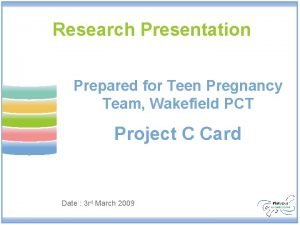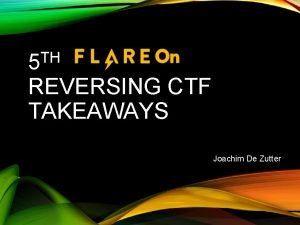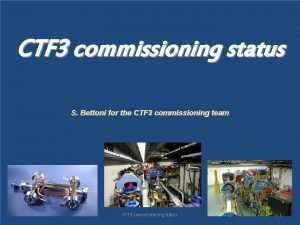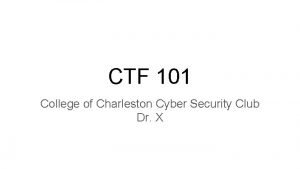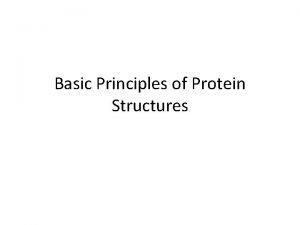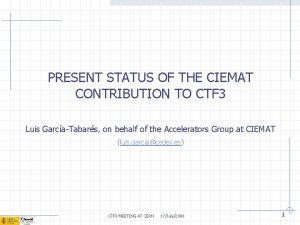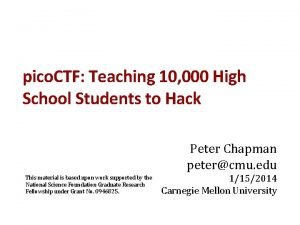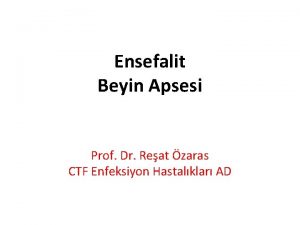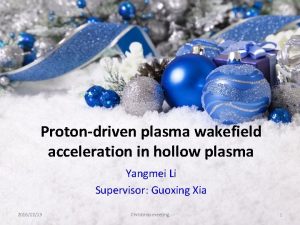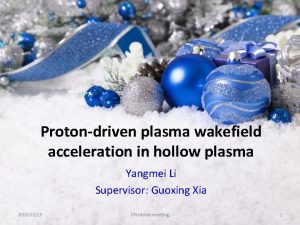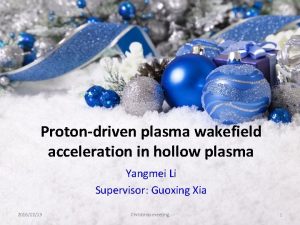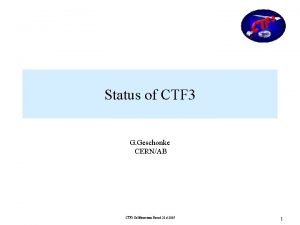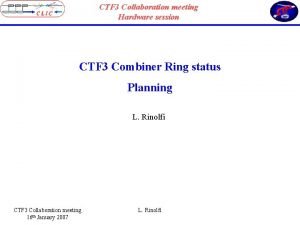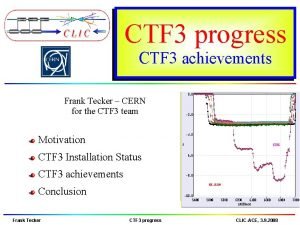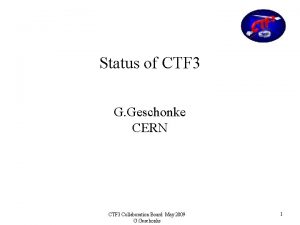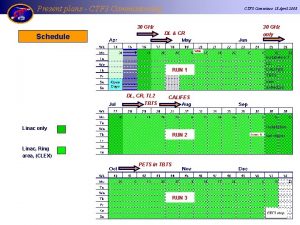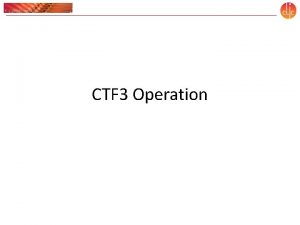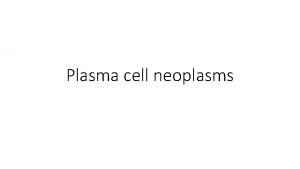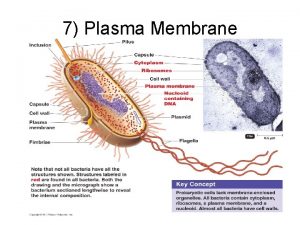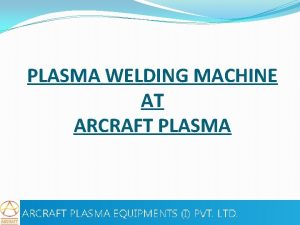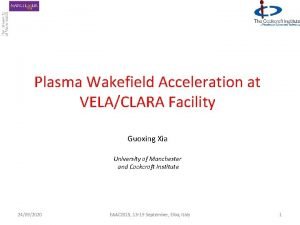CTF 3 as a plasma wakefield acceleraton test


















- Slides: 18

CTF 3 as a plasma wakefield acceleraton test facility? First thoughts Erik Adli Department of Physics, University of Oslo, Norway Input from: Steffen Doebert, Wilfried Farabolini, Patric Muggli, Chris Clayton All PIC simulations performed with the code Quick. PIC (W. An, W. Mori, UCLA) CLIC Project Meeting 2014 -12 -16 Erik Adli CLIC Project Meeting, CERN, CH 1

CLIC Test Facility 3 Shut down planned at the end 2016 Accelerators +rich infrastructure of diagnostics and control “up for grabs” Recent years : increased interest in plasma wakefield acceleration (PWFA) Can CTF 3 be converted to a plasma wakefield acceleration test facility? Erik Adli CLIC Project Meeting, CERN, CH 2

Beam driven PWFA: Two-bunch acceleration. A drive bunch drives a plasma wake, being decelerated. A witness bunch extract the wake energy, being accelerated. PWFA has potential for: - High gradient (>10 GV/m) - High efficiency (>50%) - Low energy spread (<1%) - High charge (~n. C) - Emittance preservation Not discussed here: laser driven plasma wakefield acceleration. Erik Adli Above: PIC simulation based on example parameters from the PWFA-LC design study. CLIC Project Meeting, CERN, CH 3

Possible application - PWFA-LC? Concept for PWFA-LC layout for 1 Te. V. Based on earlier work from 2009 by Raubenheimer et al. J. P. Delahaye, E. Adli et al. , “A beam driven Plasma Wake-Field Linear Collider”, CSS 2013 and ar. Xiv: 1308. 1145 Erik Adli CLIC Project Meeting, CERN, CH 4

Energy efficiency in a PWFA-LC Shaping of the WB may increase this number. Shaping of the DB may reduce this number. The total beam to beam efficiency of 50% is, together with the gradient, what makes the PWFA-LC a potentially very interesting option for a future linear collider. Erik Adli CLIC Project Meeting, CERN, CH 5

Experimental progress in PWFA High gradient (~50 GV/m) demonstrated several years ago; SLAC linac energy doubling of beam tail. Blumenfeld, I. et al. Nature 445, 741 (2007). M. Litos et al. , Nature 515, 92 (2014) Acceleration of a witness beam, with high efficiency (>30% wake to beam), high gradient (5 GV/m) and low energy spread (~1%) recently demonstrated at SLAC/FACET. See CERN A&T seminar with C. Joshi, Dec 18. Erik Adli CLIC Project Meeting, CERN, CH 6

PWFA: still in R&D phase Much experimental work needed to fully demonstrate PWFA for applications, and especially for a LC, including studies of : - emittance preservation - beam loading and efficiency - drive bunch depletion - injection, extraction and matching - staging - plasma relaxation time Other test facilities for beam driven PWFA : - FACET: one e- bunch split (end mid-2016) - FLASH-FORWARD: one e-bunch + laser plasma injector - Plus other experiments in LAOLA - ATF 2 @ Brookhaven: one e-bunch split The above don’t have two independent beam lines - AWAKE: self-modulated p bunch + e-, but very specialized expt. - FACET II: separate witness bunch injector, not yet funded Erik Adli CLIC Project Meeting, CERN, CH 7

CTF 3 beam parameters • CTF 3 has two independent beam lines. Strong asset. This allows for a test-facility which is closer to a beam driven PWFA application than current projects. • CTF 3 is equipped with extensive beam diagnostics. Strong advantage, as precise knowledge of incoming and outgoing beam parameters is key to performing precise plasma experiments (this point has been challenging at FACET). • The CTF 3 parameters are far from PWFA-LC parameters (20 Ge. V beams, short bunches), however, physics scale with plasma density, n 0. • This will not be a high-gradient facility (in the sense GV/m), however, a new test facility does not need to demonstrate high gradient in a plasma. This has already been demonstrated numerous times. Erik Adli CLIC Project Meeting, CERN, CH 8

A test facility for the PWFA-LC The PWFA-LC is based on co-linear two-beam acceleration in a plasma cell. A test facility would include injection and matching the bunches to the plasma cell, plus extraction and diagnostics. DB MB plasma cell PWFA in the blow-out regime The PWFA-LC is based on acceleration in the “blow-out regime”; DB blows out all the plasma electrons; linear focusing and uniform Ez. This requires bunch density, nb, higher than the plasma density, n 0. -> high bunch density required. Fields scales as √Ipeak -> high peak current required. How short bunches are required? Erik Adli CLIC Project Meeting, CERN, CH 9

PIC simulations of parameters On the next slides I will show a few PIC simulations where I use parameters based on the new DB injector as plasma DB, and CALIFES as plasma WB. The DB bunch length must be shortened in order to drive a clean blow-out wake; it must as least be shorter than the plasma wavelength. Erik Adli CLIC Project Meeting, CERN, CH 10

DB must be shortened Sz {DB, WB} = {150, 300} um n 0 = 3. 6 x 1014/cm 3 Initial time step. E 0 = 150 Me. V Erik Adli The blow-out “bubble” will have length of size ~ lp ~ 1 mm Electron density Longitudinal field CLIC Project Meeting, CERN, CH 11

Shortening WB as well sz = {150, 150} um n 0 = 3. 6 x 1014/cm 3 Initial time step. Erik Adli CLIC Project Meeting, CERN, CH 12

Drive bunch eroded after 1 m sz = {150, 150} um n 0 = 3. 6 x 1014/cm 3 s = 1. 0 m Erik Adli CLIC Project Meeting, CERN, CH 13

Lowering DB emittance from 100 um to 10 um sz = {150, 150} um n 0 = 3. 6 x 1014/cm 3 ez. N, DB = 10 um s = 0. 5 m Erik Adli In this scenario, the blow-out is clean until the full drive beam depletion, and excellent emittance preservation of the WB is predicted by the simulations. CLIC Project Meeting, CERN, CH 14

Parameters Conclusion: moving from CTF 3 to a PWFA test facility requires some degree of bunch compression, and ideally single drive bunches. • Is the level of bunch compression required possible to perform in the CTF 3 complex, with added beamlines? • Is there a way to extract single bunches from drive beam? Fast kickers, deflecting cavities? • However, it is clear that a DC gun is far from ideal as DB source; an RF gun is the natural solution. • Synergies with an XFEL test-facility? Erik Adli CLIC Project Meeting, CERN, CH 15

Plasma sources Requirement: plasmas source of 1 -2 m, with relatively uniform plasma density of n 0 = 1014/cm 3 – 1015/cm 3. Requirements on the source are less stringent than the sources for FACET and AWAKE. Sources based on gas discharge, not requiring expensive ionization laser, can be considered. The source would in this case not be a significant cost driver. Erik Adli CLIC Project Meeting, CERN, CH 16

More details of the science case Experimental steps towards verifying PWFA for applications : 1) external injection of e- beam • verification of few um emittance preservation of a matched WB in the blow out regime. The matched beta function is ~ 10 cm, which can be achieved. (Matching can not be achieved in FACET) • “pump depletion” of drive bunch – limits? Basically a TBL experiment in plasma. • phase stability and reproducibility of PWFA acceleration 2) plasma relaxation time drive bunch trains at 1 GHz, combined with arbitrary timed witness bunch injection. This experiment is important in particular because the PWFA-LC plans few 10 k. Hz rep rate] – Erik Adli 3) Multiple stages with interstage optics 4) Can e+ be revived? CLIC Project Meeting, CERN, CH 17

Conclusions • In order to demonstrate the feasibility of plasma for accelerator applications, there is need for additional test facilities • CTF 3 has good potential to perform interesting plasma experiments • Bunches would need to be compressed by a significant factor • Single bunch capabilities for the DB is a strongly desired • If interest from the CERN/CLIC side I would be interested in working together to further develop the ideas presented here Erik Adli CLIC Project Meeting, CERN, CH 18
